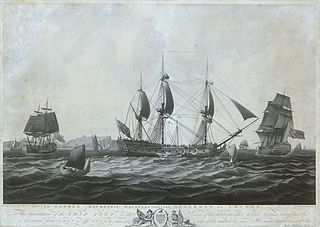Britannia may refer to any one of a large number of ships:
Many vessels have been named Minerva for the mythological figure Minerva:

Fortitude was a merchant vessel built in 1780 on the River Thames. A French frigate captured her in 1782 while she was on the return leg of her maiden voyage to India as an East Indiaman for the British East India Company (EIC). However, the British recaptured her in October 1782. The EIC purchased her and sent her back to England. There, in 1785, George Macartney Macauley purchased her and renamed her Pitt. She then performed five voyages for the British East India Company (EIC) between 1786 and 1798. In between, she made one journey transporting convicts from England to New South Wales. She was broken up in 1801.
Several vessels have been named Thames, for the River Thames:
A number of ships have been named Asia, including:
Numerous ships with the name Phoenix, for the constellation or the mythical bird, have sailed for the British East India Company (EIC) between 1680 and 1821:

Pondicherry was a French East Indiaman, launched in December 1754, that the Royal Navy captured in 1756, early in the Seven Years' War with France. She was then sold and her new owners, who renamed her Pitt, proceeded to charter her to the British East India Company (EIC), for three voyages. During her first voyage she engaged a French warship, and then went on to chart a new route, Pitt's Passage, through the East Indies on the way to China. The EIC found this new route of the utmost importance as it was faster than their existing route, and was navigable in all seasons. After her return from her third voyage Pitt disappears from readily available online sources.

Four vessels with the name Princess Royal have served the British East India Company (EIC).
Several British vessels have been named King George for one of the members of the British monarchs:
Several vessels have been named Harriet, or Harriot:
In the early 1800s several ships were named Earl St Vincent for John Jervis, 1st Earl of St Vincent:
Several vessels have been named William Pitt for William Pitt, 1st Earl of Chatham (1708–1778), a.k.a. William Pitt the Elder, British prime minister (1766–1768) or William Pitt the Younger (1759–1806), son of the above and British prime minister.
Sarah Christiana was launched in 1798. She made one voyage as an "extra ship" for the British East India Company (EIC). She then made a voyage to Jamaica. On her return, the EIC engaged her for four more voyages as an East Indiaman. In 1810 she was sold and became a West Indiaman. She was wrecked broken up in 1828.
Several ships been named Royal George after various members of the House of Hanover.
Several ships have been named Charlton:
Several ships have been named Swallow for the bird Swallow:
Five ships named Walpole have sailed as an East Indiaman for the British East India Company (EIC):
William Pitt was launched on the River Thames in 1785 as an East Indiaman. She made six voyages for the British East India Company (EIC). During her fourth she served as an ad hoc warship in a naval campaign during which she saw action. Thereafter she served as a transport, including one voyage in 1801-1802 transporting rice from Bengal to Britain. She was sold for breaking up in 1809.
This page is based on this
Wikipedia article Text is available under the
CC BY-SA 4.0 license; additional terms may apply.
Images, videos and audio are available under their respective licenses.


